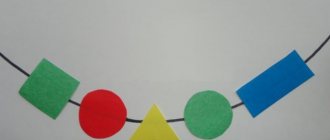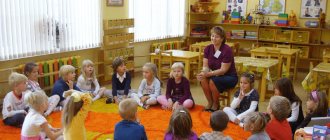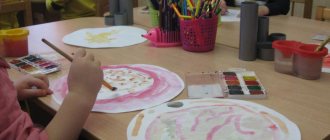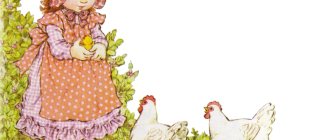GCD move
Psycho-gymnastics: “Friendly guys”
All the children gathered in a circle,
And let's smile at each other. -Guys, I will smile at you, and you smile at each other and at me, so that you and I will be in a good mood.
Guys, today on the way to kindergarten Dunno gave me this little bag and asked me to figure out what was in it. Ready?
- Children, look what I brought you today? (wonderful bag)
.
- Yes, this is a wonderful bag I have and there are various objects inside it. Want to see what's there?
- What do we have? (ball)
What color is it?
(green)
.
That's right, well done. Now will Vika get us another ball? What color is it? (blue)
.
- What actions can be done with our figures? (ride)
.
Who wants to ride? (several children try to roll)
- Let's see what else we have in the bag. What is this? ( cylinder )
.
What color is it? Masha, can you get another cylinder ?
What color is it? — What can you do with the cylinder ? (roll, put)
-How are a cylinder and a ball ? (they can be rolled)
- What is the difference between a ball and a cylinder ? ( a cylinder can be placed , but a ball cannot)
. That's right, well done.
- Now let's take out all the other cylinders and put them in a row one after another. (children take turns taking out cylinders )
.
— How many cylinders did you get ? Let's do the math. Varya, do the math. Vania? Correctly, we got 6 cylinders . How are they different from each other? (color)
.
- Let's name the color of each cylinder . Which is the yellow cylinder ? What color is the third cylinder ?
Part 3. Game exercise “Put the same”
- Now let's put all these cylinders in a certain way. Place the red cylinder in first place , the blue one in second place, and now place the yellow cylinder between blue and red. Where is the red cylinder ? Where is blue?
— Place cylinder cylinders . Let's now calculate where each color stands? (example)
.
Part 4 Didactic game “Find yourself a partner”
- Now we’ll play with you. Take one item at a time from our wonderful bag. Kostya, what do you have? What color is it? (I ask each child)
- Now we stand on the carpet with the boys and listen carefully to the rules of the game. When I say "run away"
you run around
the group , and when you hear “we’re looking for a mate,”
you must find a mate with the same item. Vanya, you have a ball, so you have to look for the child who has the ball in his hands. It's clear?
The game is repeated 2-3 times (each time the game is repeated, I specify by what characteristics we are looking for a pair : color, shape, size.
Game “Slam, stomp - make no mistake”
Eight shows the children a number, and the children must clap as many times as shown in the picture with the number. (count to six)
.
- What did we do in class ? What geometric figures did you become familiar with ? What actions can you do with them? Did they help Dunno figure out what was hidden in the magic bag?
Summary of a lesson on FEMP in the middle group based on the fairy tale “The Ryaba Hen” Summary of educational activities on FEMP in the middle A group based on the fairy tale “The Ryaba Hen” Developed by: teacher Stepanenko V. A Purpose: consolidation of knowledge.
Preview:
Municipal state-owned preschool educational institution “Kindergarten of a combined type No. 2 “Smile” in Medvezhyegorsk.
Topic: “Geometric figure cylinder.
Comparing items by width"
Objectives: learn to compare objects by width,
introduce geometric figure
cylinder, practice counting to 5.
- Guys, look what I have in my hands (Roller.) What is it for? (Paint the walls and ceilings.) What geometric figure does it resemble? This figure is called a cylinder. The top and bottom of this figure consists of two circles. It also rolls well. What objects from life are similar to a cylinder (top hat, jar, sausage, pan) (I show pictures with cylindrical objects.)
Game "Find your house." There are objects of different geometric shapes on the table, everyone takes one object and takes it to the house where cylinders, cones, balls, and cubes live.
Comparison of objects by width. I will give you two strips of paper of different widths, place one strip on top of the other. Which lane is wider, which is narrower? Compare two books by width (I give any child books to compare). Which book is narrower, which is wider? Compare two leaves from the herbarium (I give two leaves for comparison). Which leaf is narrower and which is wider? Compare two cylinders (I show two cylinders glued together from rectangular sheets of paper, I lower the narrow cylinder into the wide one, then I lower the wide cylinder onto the narrow one, placing them side by side). Which cylinder is wide and which is narrow? (I invite several children to compare the cylinders in the same way).
Physical exercise. One, two, three, four, five - We can all count. Once! Get up, stretch. Two! Bend over, straighten up. Three! Three claps of hands, three nods of the head. By four – your arms are wider. Five - wave your arms. Six - sit quietly on a chair.
Numbers from 1 to 5 are attached to the board in any order. Children need to match them with cards with the corresponding number of objects.
I name any number, and the children name the number next to mine.
- I put five hoops on the floor, and an object in the middle of each. Children close their eyes, the teacher swaps objects or removes one object. Having opened their eyes, the children, using the ordinal count, must say in which count of the hoop changes have occurred.
Bottom line. What did you and I do today? What did you like? What new did you learn?
Summary of the lesson on FEMP in the middle group “Introduction to the cylinder and ball”
Rimma Mazur
Summary of the lesson on FEMP in the middle group “Introduction to the cylinder and ball”
Goal: continue to formulate the ordinal value of a number (within 6, consolidate the ability to answer the questions “How much?”
,
“Which one?”
.
Educational: introduce the cylinder , teach to distinguish between a ball and a cylinder .
Developmental: develop memory, imagination, thinking, attention; develop the ability to compare objects by color, shape, size.
Educational: to cultivate interest in activities .
On the topic: methodological developments, presentations and notes
Fix the names of geometric shapes. Continue to classify geometric shapes according to different criteria: color, shape, size. Repeat counting within three. Learn to construct figures from counting.
A lesson on fixing geometric shapes and classifying them according to various criteria.
Mathematics lesson in the middle group. Topic: “Geometric figures” Objectives: Identify the acquired knowledge, ideas, skills that children acquired during the school year. Improve the ability to p.
EDUCATIONAL AREAS: “SPEECH DEVELOPMENT”, “SOCIO-COMMUNICATIVE”, “COGNITIVE”, “ARTISTIC-AESTHETIC DEVELOPMENT”, “PHYSICAL.
MDOU CRR kindergarten No. 4 “Golden Key” Konstantinovsk, Rostov region. Summary of GCD on FEMP in the middle group. author: Kryukova Svetlana Yuryevna Educator I qual.
Integrated lesson aimed at developing elementary mathematical concepts.
Source






